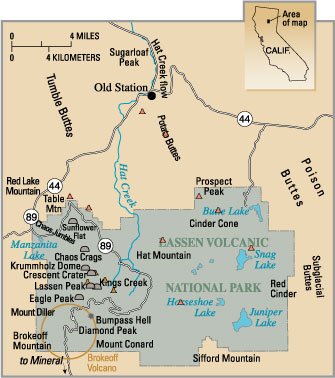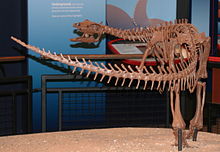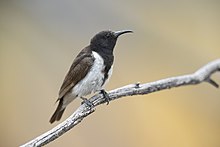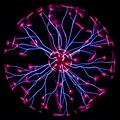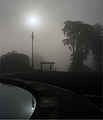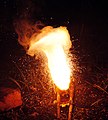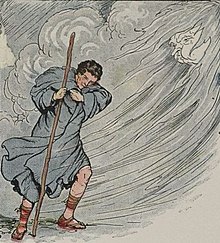Science portal

Science is a rigorous, systematic endeavor that builds and organizes knowledge in the form of testable explanations and predictions about the world. Modern science is typically divided into three major branches: the natural sciences (e.g., physics, chemistry, and biology), which study the physical world; the social sciences (e.g., economics, psychology, and sociology), which study individuals and societies; and the formal sciences (e.g., logic, mathematics, and theoretical computer science), which study formal systems, governed by axioms and rules. There is disagreement whether the formal sciences are science disciplines, as they do not rely on empirical evidence. Applied sciences are disciplines that use scientific knowledge for practical purposes, such as in engineering and medicine. ( Full article...)
Featured article -
Featured pictures
Vital articles
Agriculture encompasses crop and livestock production, aquaculture, fisheries, and forestry for food and non-food products. Agriculture was the key development in the rise of sedentary human civilization, whereby farming of domesticated species created food surpluses that enabled people to live in cities. While humans started gathering grains at least 105,000 years ago, nascent farmers only began planting them around 11,500 years ago. Sheep, goats, pigs, and cattle were domesticated around 10,000 years ago. Plants were independently cultivated in at least 11 regions of the world. In the 20th century, industrial agriculture based on large-scale monocultures came to dominate agricultural output. ( Full article...)
Did you know...
- ... that characters from several different science fiction media appear as an Easter egg in the episode " Babylon's Ashes"?
- ... that Ana Štěrba-Böhm became the first Slovene woman with a doctorate in science, in 1911?
- ... that the Science Fiction Awards Database also covers fantasy and horror?
- ... that after men took all the 2021 Nobel Prizes for science, one of the selectors, Eva Olsson, said "we want to have more women nominated"?
- ... that Charlie Jane Anders wrote preferred pronouns into her science fiction novel Victories Greater Than Death because she thought that alien gender would be unclear to humans?
- ... that some of the optics for the James Webb Space Telescope were made at the NETPark science park in northern England?
Get involved
| This portal needs to be updated. Please help update this portal to reflect recent events or newly available information. Relevant discussion may be found on the talk page. |

|
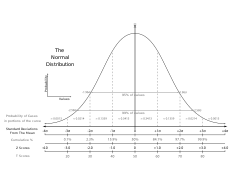
|
Science News
- 4 April 2024 – 2020–2024 H5N1 outbreak
- Scientists from the Federation University Australia report that thousands of Adélie penguins have been found dead in Antarctica amid an increase in bird flu cases among wild bird populations. (Reuters)
- 4 April 2024 –
- Researchers at the Dark Energy Spectroscopic Instrument in Arizona, United States, release the largest 3D map of the universe featuring more than six million galaxies. Using this map, researchers are able to measure the acceleration of the expansion rate of the universe with unprecedented accuracy, detecting hints that the rate of expansion has been increasing over time. (The Guardian) (Berkeley Lab)
- 12 March 2024 –
- A scientific expedition to the Bounty Trough off the coast of New Zealand reports the discovery of more than one hundred new species. (The New York Times)
- 28 February 2024 –
- The Canadian government releases its report into the high-profile firings of two scientists from the National Microbiology Laboratory in Winnipeg, Manitoba, in 2021, stating that the pair worked closely and covertly with the Chinese government. (National Post)
- 20 February 2024 –
- Astronomers identify the most luminous object ever observed, QSO J0529-4351, a quasar that accretes around one solar mass per day. (The Guardian) (Nature.com)
Related portals
Top 10 WikiProject Science Popular articles of the month -
Categories -
Science portal

Science is a rigorous, systematic endeavor that builds and organizes knowledge in the form of testable explanations and predictions about the world. Modern science is typically divided into three major branches: the natural sciences (e.g., physics, chemistry, and biology), which study the physical world; the social sciences (e.g., economics, psychology, and sociology), which study individuals and societies; and the formal sciences (e.g., logic, mathematics, and theoretical computer science), which study formal systems, governed by axioms and rules. There is disagreement whether the formal sciences are science disciplines, as they do not rely on empirical evidence. Applied sciences are disciplines that use scientific knowledge for practical purposes, such as in engineering and medicine. ( Full article...)
Featured article -
Featured pictures
Vital articles
Agriculture encompasses crop and livestock production, aquaculture, fisheries, and forestry for food and non-food products. Agriculture was the key development in the rise of sedentary human civilization, whereby farming of domesticated species created food surpluses that enabled people to live in cities. While humans started gathering grains at least 105,000 years ago, nascent farmers only began planting them around 11,500 years ago. Sheep, goats, pigs, and cattle were domesticated around 10,000 years ago. Plants were independently cultivated in at least 11 regions of the world. In the 20th century, industrial agriculture based on large-scale monocultures came to dominate agricultural output. ( Full article...)
Did you know...
- ... that characters from several different science fiction media appear as an Easter egg in the episode " Babylon's Ashes"?
- ... that Ana Štěrba-Böhm became the first Slovene woman with a doctorate in science, in 1911?
- ... that the Science Fiction Awards Database also covers fantasy and horror?
- ... that after men took all the 2021 Nobel Prizes for science, one of the selectors, Eva Olsson, said "we want to have more women nominated"?
- ... that Charlie Jane Anders wrote preferred pronouns into her science fiction novel Victories Greater Than Death because she thought that alien gender would be unclear to humans?
- ... that some of the optics for the James Webb Space Telescope were made at the NETPark science park in northern England?
Get involved
| This portal needs to be updated. Please help update this portal to reflect recent events or newly available information. Relevant discussion may be found on the talk page. |

|

|
Science News
- 4 April 2024 – 2020–2024 H5N1 outbreak
- Scientists from the Federation University Australia report that thousands of Adélie penguins have been found dead in Antarctica amid an increase in bird flu cases among wild bird populations. (Reuters)
- 4 April 2024 –
- Researchers at the Dark Energy Spectroscopic Instrument in Arizona, United States, release the largest 3D map of the universe featuring more than six million galaxies. Using this map, researchers are able to measure the acceleration of the expansion rate of the universe with unprecedented accuracy, detecting hints that the rate of expansion has been increasing over time. (The Guardian) (Berkeley Lab)
- 12 March 2024 –
- A scientific expedition to the Bounty Trough off the coast of New Zealand reports the discovery of more than one hundred new species. (The New York Times)
- 28 February 2024 –
- The Canadian government releases its report into the high-profile firings of two scientists from the National Microbiology Laboratory in Winnipeg, Manitoba, in 2021, stating that the pair worked closely and covertly with the Chinese government. (National Post)
- 20 February 2024 –
- Astronomers identify the most luminous object ever observed, QSO J0529-4351, a quasar that accretes around one solar mass per day. (The Guardian) (Nature.com)

